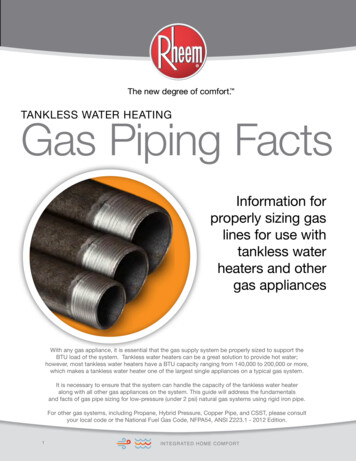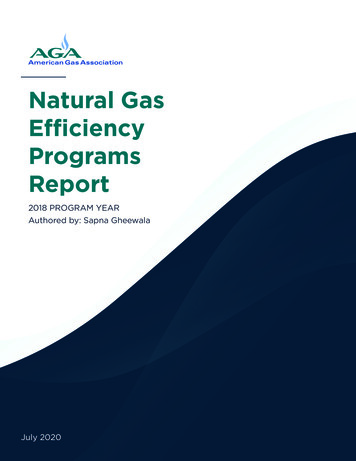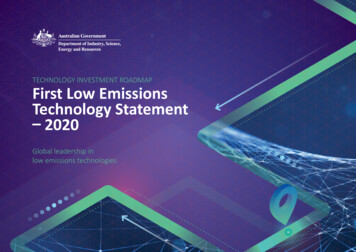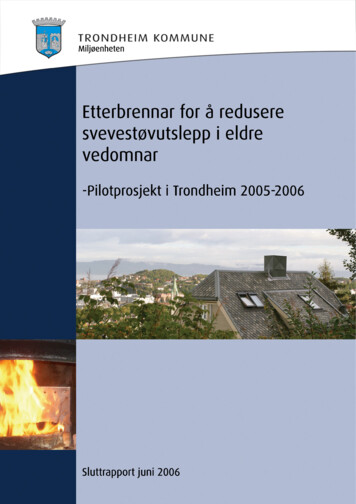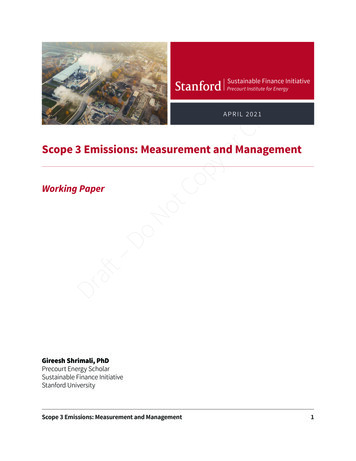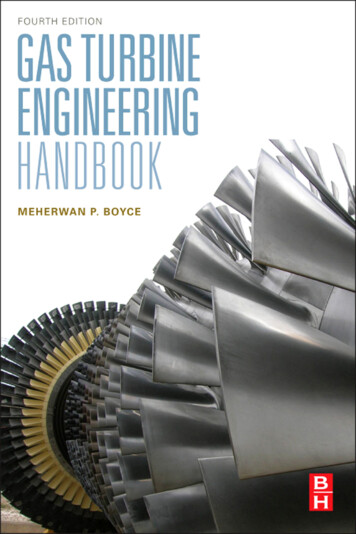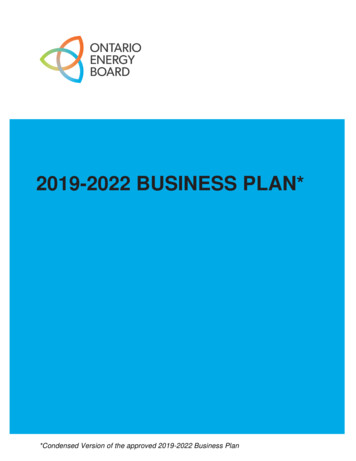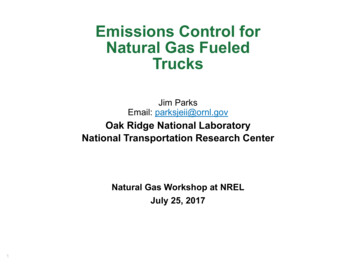
Transcription
Emissions Control forNatural Gas FueledTrucksJim ParksEmail: parksjeii@ornl.govOak Ridge National LaboratoryNational Transportation Research CenterNatural Gas Workshop at NRELJuly 25, 20171
Emission Regulations “Emissions” can mean – Greenhouse Gas Emissions– Criteria Emissions that affect air quality Of which, criteria emissions include: oxides of nitrogen (NOx), nonmethane hydrocarbon (MMHC), carbon monoxide (CO), particulate matter(PM) Also, evaporative emissions, ammonia (NH3), and Mobile Source AirToxics are of concern EPA Federal regulations for Medium-Duty and Heavy-Duty trucks:– Greenhouse Gas Emissions Standards and Fuel Efficiency Standards forMedium- and Heavy-Duty Engines and Vehicles (Phase 1 and Phase 2) Includes emission regulations for CO2 as well as N2O and CH4– Exhaust Emission Standards for Heavy-Duty Highway Spark-Ignition andCompression-Ignition Engines Includes NOx, NMHC, CO, and PM2“Greenhouse Gas Emissions and Fuel Efficiency Standards for Medium- and Heavy-Duty Engines and Vehicles—Phase 2”, Federal Register, Vol. 81, No. 206, pp. 73478-74274 (2016).“Greenhouse Gas Emissions Standards and Fuel Efficiency Standards for Medium- and Heavy-Duty Engines andVehicles (Phase 1)”, Federal Register, Vol. 76, No. 179, pp. 57106-57513 (2011).“Control of Air Pollution from New Motor Vehicles: Heavy-Duty Engine and Vehicle Standards and Highway DieselFuel Sulfur Control Requirements”, Federal Register, Vol. 66, No. 12, pp. 5002-5193 (2001).
Leakage of CH4 is a critical factor in Well-to-WheelsGreenhouse Gas emission analysis of NG for transportation Concern over NG leakage as GHG problem has been expressed in multiple publications Leak rates uncertain but can easily overwhelm contribution from tailpipe emissions3Jason Mathers, “Minimizing methane emissions”, Diesel Emissions Conference andDiesel Exhaust Fluid (2013).
Variations in upstream chemistry/processes affect tailpipeemissionsIncreased availability of NG via tight gas productionfrom shale enables low cost fuel potentialNG SourceVariations in NG composition and contaminants at enduse point (engine/vehicle) exist and are a concernDistributionNG variability that affects combustion will affectexhaust composition; if controls mitigate effects,emissions changes mitigated tooNG EngineEngine emissions (species andtemperature) depend on combustion(lean vs. stoich) and inlet fuel chemistryEngine EmissionsNG engine aftertreatment shares similarcomponents to gasoline/diesel engines, butapplication design differs (for CH4, etc.)AftertreatmentNMOG4CH4N2OCONOxPMRegulated species: need to assess sulfurimpacts and define hydrocarbon chemistry;PM also a potential concernCH4 and N2O impact Greenhouse Gas emissions requirements;oxidation of CH4 notoriously difficult for catalysts
Natural Gas fuel variation characterized in CRC Report NG Characteristics that Vary (as functionof time and region)– Methane Number [89.5-103] (highervalue means more CH4 content)– Moisture content (due tocompression/handling at distributionend) [0-11 lbm/MMscf]– Wobbe index (higher heatingvalue/square root of specific gravity)– Heavy HC (C12 ) content [impuritylevels, varies site to site, zero somesites] (from compressor oil)– Sulfur content [0-8 ppmw] Includes carbonyl sulfide, alkanesulfides, mercaptans, anddisulfides (but not H2S)Variations on these scaleswill minimally affectaftertreatment if simplypassed through to exhaust,but if variations causecontrol issues, criteriapollutant levels could changeand affect aftertreatmentSulfur always an issue forcatalysts“Natural Gas Vehicle Fuel Survey”, CRC Project No. PC-2-12, June 20145
Emissions control challenges differ with combustionstrategy, but common fundamental challenges emergeEfficiency Increases, BUT Exhaust Temperatures DecreaseStoichiometricSpark IgnitionLean PremixedSpark IgnitionThree-WayCatalyst (TWC)LeanAftertreatmentw/ NG, LowTempsLean PremixedDiesel PilotDirect InjectionDiesel PilotLean Aftertreatmentw/ NG, Diesel, ommon Need #1: Efficient Catalytic Conversion of CH4 at Low TemperaturesCommon Need #2: Efficient Reductant/Fuel Utilization (and choice)*Common Need #3: Cost- and Size-Effective and Durable Aftertreatment6*Note: Greenhouse Gas Emissions resulting from urea production are now commonin regulatory analysis of overall vehicle Greenhouse Gas Emissions
Common Need #1: Efficient Catalytic Conversion of CH4 at Low Temperatures
CH4 oxidation “light-off” over oxidation catalysts occursat higher temperatures than HCs with C-C bonds CH4 oxidation fundamentally more challenging than other HCs8Joseph R. Theis, Robert W. McCabe, “The effects of high temperature lean exposure onthe subsequent HC conversion of automotive catalysts”, Catalysis Today 184 (2012)262-270.
Many challenges are associated with catalytic conversionof CH49 Platinum Group Metal (PGM) catalystsare needed for CH4 oxidation with Pdgiving the best CH4 oxidationperformanceCost Low temperature CH4 conversion isextremely difficultEfficiency Oxidative state of active site (Pd vs.PdO) affects CH4 conversionControls Short-term thermal exposure historyaffects CH4 conversionControls CH4 conversion sensitive to poisoningby Sulfur and other impuritiesDurability
CH4 conversion has multiple impacts on efficiency andemissions of the systemCH4(GreenhouseGas) ControlThermal Management(exotherm from CH4oxidation)CH4ConversionLow Fuel Penalty forLean NOx ReductionEfficientStoichiometric NOxReduction with TWCUtilization (reforming) of CH4 toenable higher combustionefficiency and lower emissions10
Common Need #2: Efficient Reductant/Fuel Utilization (and choice)*
CH4 control for lean engines presents challenge forGreenhouse Gas Emissions (ARPA-E example shown) ARPA-E GENSETS program aimed at developinghigh efficiency natural-gas-fueled CHP generatorsfor residential applications Team led by Mahle Powertrain developing an ultralean-burn genset– uses Mahle Jet Ignition (fueled pre-chamber) Project currently on track to meet GENSETSprogram goals except GHG emissions– CH4 accounts for 1/3 of GHG emissions (high GWPmultiplier)– state-of-the-art methane oxidation catalyst (MOC)unable to convert CH4 under anticipated engineexhaust temperatures and compositions (leanconditions, T 350 C)– Lean-rich cycling required for LNT (Lean NOx Trap)MOC, LNT12HXhttps://arpa-e.energy.gov/?q programs/gensetsEstimated GHG EmissionsCH4ARPA-EtargetCO2250 270 300270 300 340300 340 390CH4 conversion over MOCin synthetic exhaust mixturesλ 0.95λ 1.8λ 2.2λ 2.6
CH4 conversion to CO/H2 can enable higher engineefficiency via thermochemical recuperation GTI (Gas Technology Institute)and Cummins collaborated on aCEC project for stationary NGengines Thermochemical recuperationwas utilized to reform CH4 toCO/H2 and increase engineefficiency Durability issue in the reformingcatalyst were cited asproblematic in maintainingengine efficiency gains Durable NG reforming catalystsare needed to enablecombustion improvement13CEC Final Report by GTI, Report# cations/CEC-500-2009-011/CEC-500-2009-011.PDF)
Common Need #3: Cost- and Size-Effective and Durable Aftertreatment
Three-Way Catalysis for NG Trucks Shown Effective inCARB Project Goal of 0.02 g/bhp-hr NOx demonstrated on Cummins ISX12G (12-liter) enginewith 9-liter close coupled and 20-liter underfloor Three-Way Catalysts (TWCs) Durability and NH3 control also demonstrated Cost and size reductions and CH4 control can improve commercial outlook15Seungju Yoon (CARB), ox-cleers.pdf
Fuel impurity and lubricant component can impactemissions control systems over lifetime of vehicle High durability requirements of emissionscontrol; poison effects on degradation importantULSDNaK Biodiesel compatibility study has shown how a 1ppm impurity can impact catalysts– Study by collaborators NREL, ORNL, NBB,MECA, and Ford investigated potentialharmful effects of Ca, Na, and K on catalysts– Trace impurities NaOH/KOH from biodieselproduction process can build-up and havebig impact– Na and K displace Cu in zeolite framework– Results in Cu-oxide on surface of washcoat As NG feed streams and lubricant formulationschange, it is important to understand whatimpurities are prevalent and how to minimize– Na K come from biodiesel synthesisprocess and are regulated by producers16CaSCRULSD-FrontflowCa-FrontNa-FrontDark area is copper oxide(not soot); only observed onNa- and K-aged samplesK-FrontB20 NaSCR
Particulate Matter (PM) from NG EnginesPM related Natural Gas ExhaustConstituents Mechanical wear produces small metalparticles High Lubricant use generates organichydrocarbon (HC) aerosols Organic HC from lubricant can condenseon metal particles facilitating distributionfrom exhaust to external environment Small particle size OC and Metalcontent creates potential health concernsFigure 5. Bus-type average concentrations of V, Al,P, Zn, Na, Sr, K, Ba, Fe, Cu, organics (Org), andrBC for the EURO III, hybrid, ethanol, and CNGbuses at the depot and on-road. For K theconcentrations are divided by 100 and for Sr andBa multiplied by 100 in order to get them to thesame scale.Fuel composition and Engineoperation influence Particles size distribution Quantity of particles (#/kWh)Amirante, R., Distaso, E., Tamburrano, P., and Reitz, R.,"Measured and Predicted Soot Particle Emissions from NaturalGas Engines," SAE Technical Paper 2015-24-2518, 2015,doi:10.4271/2015-24-2518.S. Saarikoski, H. Timonen, S. Carbone, H. Kuuluvainen, J. V. Niemi, A. Kousa, T. Rönkkö,D. Worsnop, R. Hillamo & L. Pirjola (2017) Investigating the chemical species in submicronparticles emitted by city buses, Aerosol Science and Technology, 51:3, 317-329, DOI:10.1080/02786826.2016.1261992 Overall, need to study PM emissions and design specific control approaches17 Note: for diesel NG fuel engines, optimal PM control approach needs exist
Considerations relative to other emission control R&D Modeling of specific NG processes can enable improvements inemission control system design and controls optimization– CLEERS (Crosscut Lean Exhaust Emissions Reduction Simulations)is a DOE-supported initiative to simulate emission control devices www.cleers.org Thermal management may aid in keeping catalysts at optimaltemperature conditions Sensors can assist in the control of emission control systems (andengines) Controls enable emission control over a wide range of transientoperating conditions18 Low Temperature Aftertreatment Protocols are being utilized in DOEVehicle Technology Office programs to provide a common metric forcatalyst performance assessment under conditions relevant to industrystakeholders– Protocols defining exhaust compositions for NG engines will bebeneficial
Low Temperature Aftertreatment Protocol Performance:CH4 is difficult to control using commercially availableemissions control catalysts, including three-way catalystsChevy Malibu TWC“E10”:65% i-C8H1825% C6H5CH310% C2H5OHaged* 50 h 800 CC3H8CH4simulated exhaust*:λ 0.99913% H2O13% CO21670 ppm H25000 ppm CO1000 ppm NO3000 ppm C1 HC0.70-0.86% O2SV 30,000 h-1*aging and experiments conducted according to the U.S.DRIVE LTAT Low Temperature OxidationCatalyst Test Protocol19
Summary of Potential Research Needs Efficient CH4 conversion at low temperatures Efficient utilization of CH4 for emission control and efficient combustion Sensors to enable optimal control of emission control system Control strategies to optimize emission control performance duringtransient vehicle operation Thermal management strategies for optimal emissions control Assessment of durability implications from fuel composition andlubricants Assessment and mitigation of particulate matter emissions Models that capture specific NG catalyst performance Reduced fuel/reductant use for emissions control (reduce “fuel penalty”)20
Backup Slides21
CH4 oxidation via catalysis is fundamentally difficult A lot of what we know comes from producing energy more efficiently than traditionalthermal combustion in gas-turbine combustors via catalytic combustion. Abatement of CH4 emissions is, of course, much more difficult than NMHCs because themethane’s greater stability (stronger C-H bonds which are, thus, more difficult to activate). Difficulties for methane emission control from CNG vehicles enumerated as: 22 Fairly low (500-550 C) operating temperatures Fairly low (500-1000 ppm) methane concentrations Presence of water vapor and CO2 Presence of SOx ( 1 ppm) and NOxPrimary catalyst families are noble metals (primarily Pt and Pd) and, perhaps transitionmetal oxides for lean operation
Characteristics of precious metal-based catalysts formethane oxidation Pd Rh Pt, but ceria especially promotesRh performance (Oh, et al., J. Catal. 132(1991) 287 [10]) For all of these PM-based catalysts, optimumperformance is achieved at λ’s slightly lessthan 1– More fuel efficient lean operation probably willrequire a different class of catalyst materials Higher temperatures are required comparedto oxidation of other HCs, so aging (includingPM sintering) can be an even more significantissue. Water and sulfur are potent inhibitors of theCH4 oxidation reaction. Light-off curves display unusual hysteresisthat might effect control strategies (figure fromBill Epling).23
Oxidative state of active site affects CH4 conversion Amount of PdO vs. Pd on catalyst surface has significant effect on CH4conversion efficiency vs. temperature Surface chemistry effect has implications for engine air-to-fuel ratio control andcontrol optimization of catalyst conversion efficiency24R. J. Farrauto, M. C. Hobson, T. Kennelly, and E. M. Waterman, “Catalytic chemistry ofsupported palladium for combustion of methane”, Applied Catalysis A: General, 81,(1992) 227-237.
Impact of Pd oxide state on “light-off” temperaturedramatic A wide range of light-off temperatures result from the PdO vs. Pd state oncatalyst surface as controlled by lean vs. rich conditions and temperaturePerformance recoversafter catalyst exposedTo 800oC lean wherePd oxide decomposesback to metallic Pd25CH4 lightoff performancegradually degrades asPd is increasingly oxidizedduring successive leantemperature ramps tohigher temperaturesJoseph R. Theis, Robert W. McCabe, “The effects of high temperature lean exposure onthe subsequent HC conversion of automotive catalysts”, Catalysis Today 184 (2012)262-270.
Jul 25, 2017 · big impact – Na and K displace Cu in zeolite framework – Results in Cu-oxide on surface of washcoat As NG feed streams and lubricant formulations change, it is important to understand what impurities are prevalent and how to minimize – Na K come from biodiesel synthesis process an

